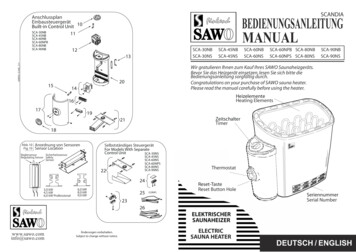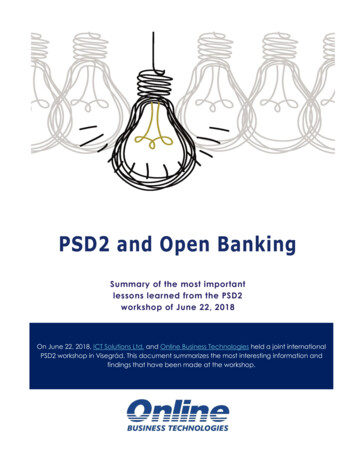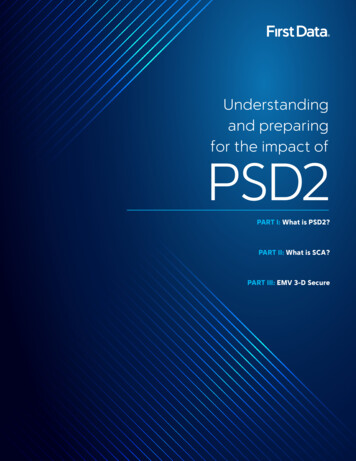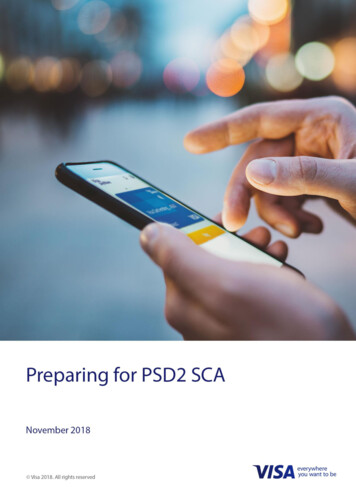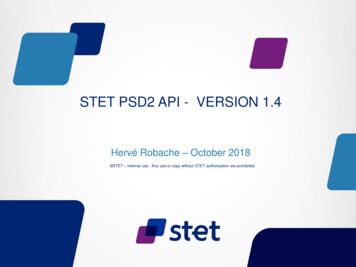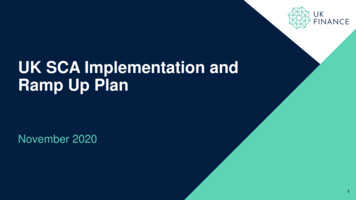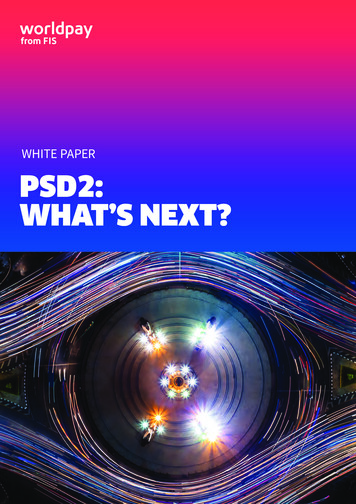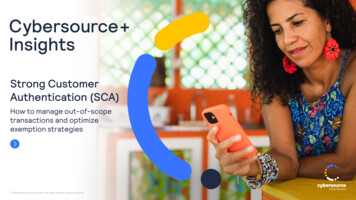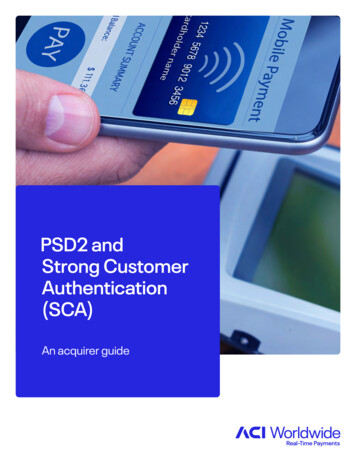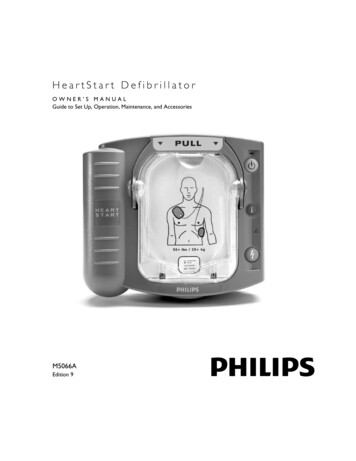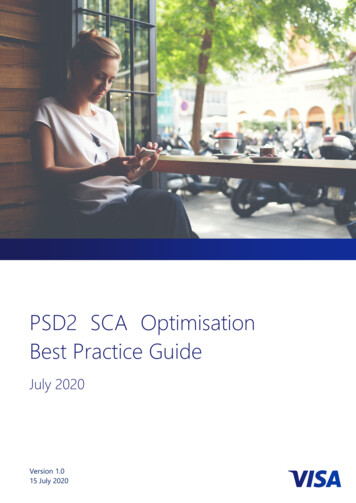
Transcription
PSD2 SCA OptimisationBest Practice GuideJuly 2020Version 1.015 July 2020
ContentsImportant Information. 3Our goal is minimising friction while managing risk . 4All parties in the e-commerce and payments ecosystem have a role to play inminimising friction . 6Step 1: Minimise fraud count . 7Step 2: Identify and flag out of scope transactions . 9What are out of Scope transactions? . 9Merchants & Acquirers need to identify and flag Out of Scope transactions . 10Issuers should not decline or request authentication for transactions that areidentified as out of scope of SCA . 12Step 3: Optimise risk management .13Merchants should use Risk Based Analysis (RBA) to minimise fraud rates andoptimise application of exemptions . 13Issuers should use Risk Based Analysis (RBA) to minimise fraud rates and optimiseapplication of exemptions. 14Step 4: Use 3-D Secure .16Step 5: Optimise for exemptions .18Guidance for merchants and Acquirers on the application of exemptions . 18Guidance for Issuers on the application of exemptions. 22Delegated Authentication . 25Summary of Visa’s risk management and SCA products .26Timescales and Mandates .27Useful References .28Version V1.015 July 20202
Important Information 2020 Visa. All Rights Reserved.The trademarks, logos, trade names and service marks, whether registered orunregistered (collectively the “Trademarks”) are Trademarks owned by Visa. All othertrademarks not attributed to Visa are the property of their respective owners.Disclaimer: Case studies, comparisons, statistics, research and recommendations areprovided “AS IS” and intended for informational purposes only and should not berelied upon for operational, marketing, legal, technical, tax, financial or other advice.As a new regulatory framework in an evolving ecosystem, the requirements for SCAstill need to be refined for some use cases. This paper represents Visa’s evolvingthinking, but it should not be taken as a definitive position or considered as legaladvice, and it is subject to change in light of competent authorities’ guidance andclarifications. Visa reserves the right to revise this guide pending further regulatorydevelopments.This guide is also not intended to ensure or guarantee compliance with regulatoryrequirements. Payment Service Providers, and Merchants are encouraged to seek theadvice of a competent professional where such advice is required.This document is not part of the Visa Rules. In the event of any conflict between anycontent in this document, any document referenced herein, any exhibit to thisdocument, or any communications concerning this document, and any content in theVisa Rules, the Visa Rules shall govern and control.Note on references to EMV 3DS, 3-D Secure 2.0 and 3DS 2.0: When in this documentwe refer to 3-D Secure 2.0, 3DS 2.0 or EMV 3DS this is a generic reference to the secondgeneration of 3-D Secure and does not reference a specific version of the EMVCospecification. Version 2.1 of the specification is referred to as EMV 3DS 2.1 and version2.2 is referred to as EMV 3DS 2.2Version V1.015 July 20203
Our goal is minimising friction while managing riskPSD2 requires that Strong Customer Authentication (SCA) is applied to electronicpayments within the European Economic Area (EEA) and the UK unless an exemptionapplies, or the payment falls into one of the out of scope categories.There are a number of steps that merchants and payment service providers (PSPs) cantake to minimise any friction experienced by customers making remote electronicpayments, while maintaining compliance with the PSD2 SCA regulation. These include:Supporting the latest version of 3-D Secure, EMV 3DS 2.2Recognising and flagging out of scope transactionsOptimising the application of exemptions to minimise the need for SCAchallenges Optimising the experience of completing an SCA challenge when required.Reducing customer friction is essential to optimising customer experience andminimising transaction abandonment. The steps that merchants and PSPs should take to minimising friction can be groupedinto two clear stages:Stage 1: Minimising the need for SCA challengesStage 2: Creating a challenge process offering minimal friction when SCAchallenges are requiredThe key steps in each stage are summarised overleaf. This guide provides merchants, Acquirers and Issuers with guidance on Stage 1,minimising the number of transactions that will require Issuers to apply SCAchallenges. See the PSD2 SCA Challenge Design Best Practice Guide for guidance onStage 2, minimising friction when SCA challenges are required.Please note that this is guide contains best practice guidance that aims to highlightthe steps that merchants, gateways, Acquirers and Issuers can take to help to minimisefriction and optimise the application of exemptions. For example, merchants shouldmaintain low fraud rates to increase the likelihood that PSPs will apply exemptions. Assuch it provides a holistic view that recognises that all players have a part to play,although it should be noted that from a regulatory point of view, exemptions can onlybe applied by regulated PSPs.Version V1.015 July 20204
Stage 1: Minimising the need for SCA challengesMerchant, Gateway & AcquirerSTEP 1:Minimise fraudcountSTEP 2:Identify Out ofScopeSTEP 3:Optimise riskmanagementSTEP 4:Use 3-D SecureSTEP 5:Optimise forexemptionsIssuerMaximise the option to apply exemptions by minimising misreported/friendly fraud through preventing/resolving disputedtransactionsIdentify & correctly flag out ofscope transactionsRecognise out of scopetransactions & do not challengethemApply risk screening to best routetransactionsApply Risk Based Analysis to alltransactionsSupport EMV 3DS 2.2 or above to ensure exemptions are appliedoptimallyTake full advantage of qualifyingexemptionsApply Issuer exemptionsStage 2: Minimising friction when SCA is requiredMerchant, Gateway & AcquirerSTEP 1:Optimise your SCAchallenge strategySTEP 2:Maximise use ofBiometricsSTEP 3:Optimiseonboarding &challenge UXSTEP 4:Mitigate potentialproblemsVersion V1.015 July 20205IssuerTake full advantage of 3DSchallenge window integrationImplement an holistic approach toserving low friction challengesPass all required 3DS data,ensuring it is correctly formatted,consistent & of high qualityMaximise the use of biometric &behavioural biometrics elementsFully utilise the UX integration &branding capabilities offered by3DSSimplify onboarding & challengeflows & ensure the UI is clearAnticipate and mitigate potential user problems associated with challengeflows & provide effective customer communication & support
All parties in the e-commerce and paymentsecosystem have a role to play in minimisingfrictionAll parties in the payments and e-commerce ecosystem including all merchants,gateways, 3-D Secure vendors, Acquirers and Issuers play a part in the application ofSCA and all need to take steps to manage risk and ensure SCA challenges are onlyapplied when required:All parties have a part to play in reducing friction:Larger Merchants Ensure e-commerce sites & apps supportEMV 3DS 2.2 & pass required 3DS data Minimise disputes with use of pre-disputetools Correctly flag out of scope transactions Deploy transaction risk screening Make full use of the acquirer TRA exemption Consider delegated authentication andusage of the trusted beneficiaries exemptionSmaller Merchants Ensure e-commerce sites & apps supportEMV 3DS 2.2 and pass required 3DS data Correctly flag out of scope transactions Check whether payment providers can helpwith dispute prevention, transaction riskscreening and PSD2 optimisationGateways, Acquirers &3DS Server Vendors Educate & support merchants in adoptingEMV 3DS 2.2 Support use of pre-dispute tools Support merchants in applying the TRAexemption Ensure merchants can correctly flag out ofscope transactions Optimise use of exemptions & challenge UXin hosted checkouts Develops and maintains EMV 3DS and VisaAttempts Server for Visa transactions Routes authentication requests via DirectoryServer Provides authorization message flags, tools& services to reduce friction Monitors performance to ensure theecosystem delivers best in class experienceto consumers while managing riskIssuers Apply Risk Based Authentication to alltransactions Do not challenge or decline unnecessarily Maximise the use of allowable exemptions Adopt SCA solutions that minimise frictionVersion V1.015 July 20206ACSsFully use available data in RBA risk modelsMigrate from rules-based to AI based RBAOffer Issuers low friction SCA solutionsIntegrate with third party low friction SCAsolutions Support 3RI
Step 1: Minimise fraud countDisputes are often marked as fraud even when they are raised only because customershave trouble recognizing transactions and not because the transaction wasunauthorised. Visa analysis indicates that fraud is reported 90% of the time a disputeis submitted 1.Such disputes can artificially and unnecessarily inflate fraud counts, limiting the abilityof Acquirers and Issuers to apply the TRA exemption and potentially limiting the abilityof individual merchants to be considered for the application of certain exemptions 2.Visa’s experience has shown that a significant proportion of both disputes andtransactions unnecessarily categorised as fraudulent can be avoided if customers andIssuers can be provided with additional information, such as the item purchased, tohelp customers validate transactions before they formally ask for a transaction to bedisputed.If merchants provide this information to Issuers itenables them to deal more effectively withcustomer queries, improving customer satisfactionIn 2019, merchants usingand removing these transactions from the fraudVerifi solutions saw precount. This can potentially improve the risk scoredispute deflection rates 3 ofof every transaction a merchant processes, whileup to 42%increasing the ability of Acquirers and Issuers toapply the TRA exemption. Merchants can alsobenefit by reducing revenue losses from disputes,as well as increasing their ability to qualify for the application of key exemptions.Verifi, a Visa company, offers a suite of related Pre-dispute Products to help bothmerchants and Issuers avoid and resolve such disputes.Source: Visa analysis from Visa Resolve Online statisticsFrom a regulatory perspective the ability to apply the TRA exemption is dependent upon the fraudrate of the PSP applying the exemption. From a wider perspective, Acquirers are more likely to considerapplying exemptions to transactions from low fraud rate merchants. In some specific cases, for example,the Visa Trusted Listing program which facilitates the application of the trusted beneficiaries exemption,merchants need to meet fraud rate targets to be enrolled and remain within the program.3The deflection rate measures the percentage of pre-disputes that were resolved at the point of inquiry,and do not subsequently become a chargeback.12Version V1.015 July 20207
Verifi Pre-dispute SolutionsVerifi pre-dispute solutions provide an opportunity for merchants,Acquirers and Issuers to collaborate and share data to prevent andresolve disputes at the pre-dispute stage.Verifi’s Order Insight (formerly Visa Merchant Purchase Inquiry) allows merchantsto share order details with Issuers through the existing Visa Resolve Online (VROL)dispute process. Enhanced transaction data is provided by merchants to Issuers forreview with cardholders at first inquiry.Order Insight Digital (formerly Visa Cardholder Purchase Inquiry) enablescardholders to access the same enhanced transaction data through an Issuer’s onlinebanking portal or mobile app. Validating the sale with the cardholder can helpprevent a dispute from being raised. Global Visa Issuers are required to receivetransaction data in VROL from participating merchants before submitting a dispute.Rapid Dispute Resolution (RDR) operates at the pre-dispute stage to resolvedisputes before they escalate, as determined by seller-defined rules in the Verifiautomated decisioning engine. Pre-disputes from other card brands can also beresolved through Verifi.From July 2020, all Verifi services are available through VROL for Issuers, or throughenrolment directly with Verifi for merchants. Interested parties should contact Verifi(info@verifi.com), or speak to their Visa representative. Small to medium Merchantsshould speak to their Acquirer about availability of these services.Version V1.015 July 20208
Step 2: Identify and flag out of scopetransactionsWhat are out of Scope transactions?The PSD2 regulation identifies some transactions as being “out of scope” of SCA. SCAdoes not need to be applied to out of scope transactions. Visa estimates thatapproximately 46% of remote transactions are out of scope. 4Transaction types out of scope of SCAA transaction, or series of transactions, of fixed or variable amount and frequency,governed by an agreement between the cardholder and merchant that, once agreed,allows the merchant to initiate subsequent payments without any direct involvementof the cardholder. Examples of MITs include subscription type payments at fixed orMerchantInitiatedTransactions(MITs)variable intervals, installment payments, pre/balance payments, payments related todelayed or split shipments, payments related to booking reservations made viaindirect channels, cancellation fees (No show), incremental authorization requests,delayed charges, and collection of payment of already delivered services (contactlesstransit only).In most cases SCA is required if the agreement is set up through a remoteelectronic channel and MITs must be identified and flagged by merchants sotheir Acquirers can flag them to Visa using the Visa MIT Framework. 5Mail Order/TelephoneOrder(MOTO)Payments made through Mail Order/Telephone Order (telephone includes InteractiveVoice Response services). Note, “voice commerce” payments initiated through digitalassistants or smart speakers are not classed as MOTO.These transactions must be identified and flagged by merchants and Acquirers. 6A transaction where either the Issuer or Acquirer is located outside the EEA or the UKOne-Leg-Out(OLO)is considered out of scope and not requiring SCA. However, SCA should still beapplied on a “best efforts” basis.These transactions are identifiable by the issuer BIN or the Acquirer locationbeing from outside the EEA or the UK. 6For more detail on identifying out scope transactions please see section 3.2.8 of Visa PSD2 SCA forRemote Electronic Transactions Implementation Guide V2.05For more detail see section 3.10 of the Visa PSD2 SCA for Remote Electronic TransactionsImplementation Guide V2.06For more detail see section 3.2.8 of the Visa PSD2 SCA for Remote Electronic TransactionsImplementation Guide V2.0 Merchants should also check how their Acquirers would like them to flagout of scope transactions as some use a proprietary standard for merchant flags and then convert theflags to the appropriate card scheme standard before submitting an authorization request.4Version V1.015 July 20209
AnonymoustransactionsTransactions through anonymous payment instruments, for example anonymousprepaid cards.These transactions cannot be recognised as such by a merchant so must beidentified by Issuers checking the BIN.6Note: Visa also considers that SCA is not required to be performed by the cardholderfor the following types of transactions: Original Credit Transactions (OCTs) 7 and refunds, as the customer is receivingrather than making a paymentSome zero value authorization/account verification requests 8Visa tools for out of scope transactionsThe Visa MIT FrameworkThe Visa MIT Framework enables Acquirers to correctly flag andidentify MIT transactions.Visa authorization message indicatorsSpecific field values in Visa authorization system messages are providedto allow merchants to identify a transaction type that an Issuer mustrecognise as out of scope and does not require the application of SCA.Issuers have the choice to recognise MITs using the Visa MIT Framework or the MITout of scope flag in Field 34 of the authorization request.Merchants & Acquirers need to identify and flag Out ofScope transactionsIf a payment transaction is out of scope of SCA, the merchant/Acquirer must submitan authorization request that includes the information the Issuer will need to processit without SCA. Transactions that are not correctly flagged in this way are at risk ofbeing declined by Issuers.OCTs are “push” payments that allow a Visa cardholder to receive funds to their eligible Visa cardaccount in near-real time. For more detail see section 3.2.8 of the Visa PSD2 SCA Implementation GuideVersion 2.0.8In some limited use cases described in section 4.6.4 of PSD2 SCA for Remote Electronic TransactionsImplementation Guide Version 2.0, SCA may be required. Refer to this section for more details onaccount verifications.7Version V1.015 July 202010
What merchants should doMerchants who process out of scope transactions need to ensure that they can identifythese transactions and populate the appropriate authorization indicators, as definedby their Acquirer. Note it is important that merchants check how their paymentgateway/Acquirer would like them to identify MITs and other out of out of scopetransactions. Some payment gateways/Acquirers use a proprietary standard formerchant flags and then convert the flags to the appropriate card scheme standardbefore submitting an authorization request.To identify MITs to be recognised as out of scope and processed without the need forSCA, a merchant or their gateway must store the transaction ID from the initialagreement set up transaction (or, in some cases, from a previous MIT) They must thenprovide it, along with the indicator identifying the type of MIT, in each MITauthorization request they subsequently submit to collect payments under theagreement.Merchants should speak to their Acquirer or payment gateway as soon as possible toagree which, if any, types of out of scope transaction they are processing, how settingup an MIT agreement should be authenticated, how all out of scope transactionsshould be identified and flagged, and how initial or prior transaction IDs should becaptured, stored and populated into authorization requests.For more information on out of scope transactions, MITs and the MITframeworkSee the Visa PSD2 SCA for Remote Electronic Transactions Implementation Guide V2.0.This guide includes much more detail in section 3.2.8 on the ways in which out ofscope transactions are identified and flagged. Section 3.10 describes the eightdifferent types of MIT defined under the MIT framework and Section 5 includesexplanations as to how MITs should be treated in a number of common and complexpayment scenarios.Version V1.015 July 202011
Issuers should not decline or request authentication fortransactions that are identified as out of scope of SCAIssuers must be able to recognise every type of out of scope transaction and must notdecline or request authentication for transactions that have been flagged as out ofscope by the Acquirer 9. They should also be able to identify transactions acquiredoutside the EEA and the UK andVisa Rule:transactions made with anonymous cards.An Issuer must not use an SCA decline Note it is important that one-leg-outcode for transactions deemed out of transactions are identified using thescope from a regulatory perspective. Acquiring Institution country and not theIssuers may only use an SCA decline merchant country code.code for these transactions when theySimilarly, Issuers should not decline orbelieve the transaction has beenrequest authentication for OCTs or relevantincorrectly flagged/is not permittedzerovalueauthorization/accountunder regulation to be out of scope9.verification requests.For more information please refer to Section 4.5 of PSD2 Strong Customer Authentication for RemoteElectronic Commerce Transactions – European Economic Area Visa Supplemental Requirements9Version V1.015 July 202012
Step 3: Optimise risk managementVisa recommends that merchants undertake risk screening on transactions beforesubmitting them to authentication or authorization. Issuers are required to apply RiskBased Analysis (RBA) to all transactions.Merchants should use Risk Based Analysis (RBA) tominimise fraud rates and optimise application ofexemptionsMerchants should ensure that RBA is part of their fraud screening processes, includedprior to authorization or authentication, improving security and also setting thefoundation for their SCA strategies.The benefits include: Merchants are likely to have the best understanding of their customers and thefraud risks associated with their businessesThe analysis undertaken by merchants can be used to apply for the Acquirer TRAexemption 10 and to enable merchants to decide whether: They would like an exemption applied or,They should submit a transaction via 3DS for potential application of SCAMerchants can also use this analysis to develop and execute exemption strategiesto minimise customer friction and fraud liability riskAt its simplest level, RBA is based upon rules set by or in conjunction with the merchantto assess the risk of a transaction based upon simple characteristics of the transaction.More sophisticated solutions increasingly use machine learning based risk models andmultiple datapoints to provide a much more accurate assessment of risk and minimiseboth fraud and false positives. The approach taken by merchants will depend upon their size, resources and the riskprofile of their business. Smaller merchants may choose by default to submit all of their transactionsvia 3DS leaving the Issuer to risk assess them and decide which transactionsqualify for exemptions. However, a merchant who applies no RBA or fraudscreening risks a higher fraud rate, the application of fewer exemptions andhigher customer friction. It is recommended that such merchants speak totheir payment gateway, acquirer or 3DS server provider to check what riskanalysis and screening services they are able to offer.Note: The Acquirer TRA exemption can only be used based on the acquirer’s overall fraud rate notany merchant-specific rate10Version V1.015 July 202013
Larger and enterprise merchants should look to adopt more proactivestrategies using more sophisticated risk tools to minimise fraud rates and takeadvantage of the ability to apply Acquirer exemptions and send transactionsdirect to authorization to minimise the impact on customer experience andauthentication costs.Merchants must align with their gateway/Acquirer to ensure that their SCA exemptionstrategy is supported. CyberSource Risk Management & Exemption DecisionToolsCyberSource, a Visa owned company, offers a full stack of payment and fraudsolutions. The CyberSource Decision Manager risk management platformincludes an SCA exemption optimisation layer. This enables merchants to makerisk-based decisions based upon their business rules, and subsequently request anexemption, via authorization or 3DS, or submit the transaction via 3DS forauthentication.CyberSource Decision Manager offers the following benefits A rules engine combined with machine learning based risk models that candetect high risk transactions and identify which transactions are out of scopeof SCA or could qualify for an SCA exemption based on risk The ability to process exempted transactions direct to authorization to reducecustomer friction and authentication costs When combined with CyberSource 3DS solutions, Decision Manager will havethe future capability to automatically resubmit transactions sent direct toauthorization via 3DS when an Issuer requires authentication.For further information on CyberSource Fraud and Payment ManagementSolutions, existing CyberSource customers should contact their CyberSourceaccount manager. Other parties can learn more, and contact CyberSource byvisiting cybersource.com.Issuers should use Risk Based Analysis (RBA) to minimisefraud rates and optimise application of exemptionsManaging risk effectively will enable Issuers to maximise their ability to applyexemptions. Issuers should aim to implement risk strategies that balance the need tokeep fraud low whilst at the same time avoiding the need to challenge every singletransaction. In the case of the TRA exemption, keeping fraud rates within the referencefraud rate for the highest achievable transaction value band can be achieved bymaking full use of 3DS data.Version V1.015 July 202014
Issuers should set strategies that clearly define the risk score thresholds that requirethe application of a 3DS challenge. These strategies should ensure that, unless SCA isrequired by the regulation: SCA is only applied when the risk score Visa Rule:exceeds a set thresholdIssuers are required to supportIssuers do not apply SCA to transactions thatRBA for EMV 3DS and mustqualify for an exemption where the risk scoreevaluate the risk level of eachis low. Doing so will unnecessarily increasetransaction using some form offriction and transaction abandonmentrisk-model, rules engine, orRisk scoring & challenge strategies arerisk analysis, and then applyregularly reviewed against fraud andthe required authenticationtransaction abandonment data and adjustedprocedure.as necessary to ensure the optimum balance ismaintainedWhere and when possible, Issuers adopt risk engines that use machine learning asa more effective alternative to rules-based scoring.Visa tools for Risk Based Analysis (RBA)VCASVisa Consumer Authentication Service (VCAS) is a data-driven hosted ACSsolution designed to support an Issuer’s authentication strategies deliveredthrough 3-D Secure. The VCAS risk model is uniquely able to access the mostcomprehensive transaction data set drawn from across the Visa’s global networkand third-party sources. VCAS assesses the risk of a transaction in real-time usingpredictive risk analysis based on a number of enhanced inputs, including deviceand transaction information and behaviours. This network-wide level ofintelligence gives Issuers the analysis required to decide if and when additionalauthentication is needed.VCAS ScoreVCAS Score is the risk assessment and transaction risk scoring engine behindVCAS. This offers a sophisticated AI based model utilising the most comprehensivetransaction data available to Issuers who use the VCAS ACS.The VCAS solution has been built in partnership with CardinalCommerce, anindustry leader in digital payment authentication that is fully owned by Visa. Formore information please see umer-authentication-service.Version V1.015 July 202015
Step 4: Use 3-D Secure3-D Secure (3DS) is the leading industry standard solution being used across the cardpayments industry to apply SCA.What is EMV 3DS 2.2 and why is it important?The latest version of 3DS, EMV 3DS 2.2,provides critical new functionality that isfundamental to the optimisation of theapplication of PSD2 SCA and allpermitted exemptions. All Issuers aremandated to support EMV 3DS 2.2 bySeptember 14, 2020 and Acquirers aremandated to ensure their merchantsare connected to vendors who supportit by October 16 2020.EMV 3DS 2.2 also provides newfunctionality required to authenticatesome complex payment use cases andoffers a better user experience thanprevious versions of 3DS. It supportspurchases made through browsers,mobile apps and other devices.What merchants should doMerchants must support 3DS tofacilitate the application of SCA which isrequired under PSD2 and Visa stronglyencourages merchants and Acquirers tosupport EMV 3DS 2.2 as early aspossible.EMV 3DS 2.2 critical new functionalityExemptions: Indicators that enablemerchants and Acquirers to takeadvantage of SCA exemptions (TRA,secure corporate payments & trustedbeneficiaries)SCA Delegation: The Visa DelegatedAuthentication program allows Issuers todelegate the performance of SCA toselected merchants or token requestors.Indicators enabling delegation areincluded in EMV 3DS 2.23RI - Allows SCA and exemptions to beapplied in complex merchant use casessuch as travel bookings or split shipmentsand for refreshed cryptograms to beissued once expired: a particular benefitfor delayed shipmentsAuthenticating with mobile apps:Improved re-directs to apps or otherexternal environments via the Out of Band(OOB) functionBiometrics: A more seamless transitionto an app makes biometric authenticationeasier for consumersMerchants new to EMV 3DS shouldnote that it is a different protocol to3DS 1.0, and they will need a 3DSServe
Version 1.0 15 July 2020 PSD2 SCA Optimisation Best Practice Guide July 2020
